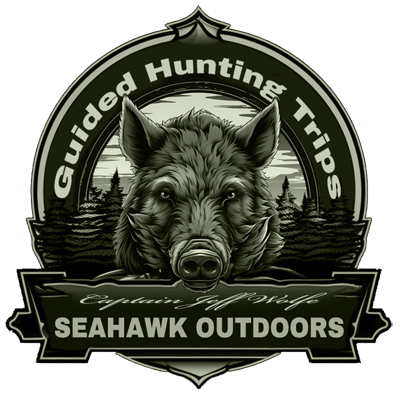North Carolina Hunting, Guided Trips
Southeastern North Carolina’s Brunswick County, Columbus County, and Bladen County. NC Hunting Locations Map.
Whether you’re a seasoned hunter or a beginner looking to delve into the hunting world, guided hunting trips provide an invaluable experience. These outings blend adventure with learning, equipping you with important skills while offering a unique chance to hunt a variety of game in diverse habitats.
Hunting has been an integral part of human culture for thousands of years, and guided hunting trips are the modern iteration of this rich tradition. A guided hunting trip is an organized hunting experience led by a professional guide or outfitter. The guide provides the necessary logistics, hunting expertise, knowledge of local regulations, and a safe and ethical hunting environment.
When it comes to hunting, nothing quite compares to the thrill of tracking a wild turkey in the dense forests and beautiful landscapes of southeastern North Carolina. The region offers a unique mix of habitats that have turned it into a haven for wild turkeys. In this guide, we’ll walk you through everything you need to know about participating in a guided wild turkey hunting trip in this area.
Wild Turkey Hunting
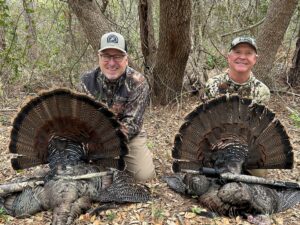 Wild turkey hunting in North Carolina is a cherished tradition among hunters worldwide. The sport is often cited as one of the most challenging yet rewarding hunting experiences. With their keen senses and skittish nature, wild turkeys present a unique test of a hunter’s skills and patience. Let’s delve deeper into the world of wild turkey hunting.
Wild turkey hunting in North Carolina is a cherished tradition among hunters worldwide. The sport is often cited as one of the most challenging yet rewarding hunting experiences. With their keen senses and skittish nature, wild turkeys present a unique test of a hunter’s skills and patience. Let’s delve deeper into the world of wild turkey hunting.
Southeastern North Carolina, with its mix of dense pine forests, hardwood bottomlands, and swampy areas, provides an ideal habitat for these impressive birds. The varied terrain adds to the appeal, offering hunters a unique and satisfying hunting experience.
Wild turkeys are intelligent and elusive creatures. They possess keen eyesight, sharp hearing, and can run up to 20 miles per hour or fly at speeds of 55 miles per hour, making them a formidable quarry. The wild turkey’s natural instincts for survival, coupled with its impressive physical capabilities, mean hunters need a blend of patience, skill, and strategy to successfully harvest a turkey.Wild Hog Hunting
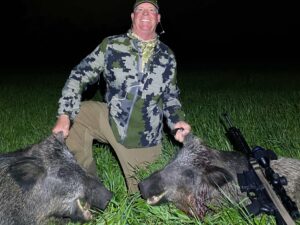 Among the multitude of hunting opportunities that southeastern North Carolina offers, wild hog hunting in North Carolina is a standout, offering thrill and excitement like no other. This region, characterized by a diverse blend of terrain from dense forests to marshy wetlands, is a flourishing habitat for wild hogs. In this guide, we delve into the particulars of engaging in a wild hog hunting trip in this bountiful hunting ground.
Among the multitude of hunting opportunities that southeastern North Carolina offers, wild hog hunting in North Carolina is a standout, offering thrill and excitement like no other. This region, characterized by a diverse blend of terrain from dense forests to marshy wetlands, is a flourishing habitat for wild hogs. In this guide, we delve into the particulars of engaging in a wild hog hunting trip in this bountiful hunting ground.
The chase for wild hogs is often marked by exhilarating encounters, unpredictability, and the test of true hunting grit. Wild hogs, also known as feral hogs, are non-native, highly adaptable animals known for their intelligence and resilience, which makes them a challenging and worthy quarry for any hunter.
In southeastern North Carolina, the thriving hog population across the dense forests, agricultural lands, and swampy areas provides ample opportunities for an unforgettable hog hunting adventure. The region’s varied terrain adds an element of intrigue and complexity to the hunt, demanding a blend of skills and strategies from hunters.
Deer Hunting
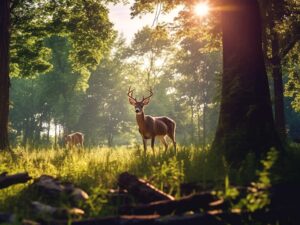 Southeastern North Carolina is a deer hunter’s paradise. Rich with dense forests, wide-open agricultural lands, and an abundance of white-tailed deer, this region is a prime destination for guided deer hunting trips. In this guide, we’re going to explore the key aspects of planning and participating in a deer hunting adventure in this hunter-friendly corner of North Carolina.
Deer hunting is a timeless tradition, a challenge of patience, skill, and respect for nature. The quarry, the white-tailed deer, is a majestic and elusive creature, renowned for its agility and keen senses. Hunting them is not just about the pursuit but also about understanding their habits, patterns, and the ecosystems they inhabit.
The southeastern part of North Carolina, boasting diverse habitats from pine forests to river bottoms, is home to a healthy population of white-tailed deer. The varied landscape offers hunters a range of hunting scenarios, each with its unique challenges and rewards.
Southeastern North Carolina is a deer hunter’s paradise. Rich with dense forests, wide-open agricultural lands, and an abundance of white-tailed deer, this region is a prime destination for guided deer hunting trips. In this guide, we’re going to explore the key aspects of planning and participating in a deer hunting adventure in this hunter-friendly corner of North Carolina.
Deer hunting is a timeless tradition, a challenge of patience, skill, and respect for nature. The quarry, the white-tailed deer, is a majestic and elusive creature, renowned for its agility and keen senses. Hunting them is not just about the pursuit but also about understanding their habits, patterns, and the ecosystems they inhabit.
The southeastern part of North Carolina, boasting diverse habitats from pine forests to river bottoms, is home to a healthy population of white-tailed deer. The varied landscape offers hunters a range of hunting scenarios, each with its unique challenges and rewards. Clapper Rail Hunting
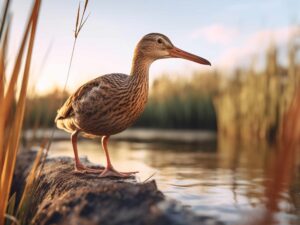 Clapper Rail hunting in North Carolina might be the niche adventure for you. Clapper Rail, often referred to as the “Marsh Hen,” is a game bird that offers a unique hunting opportunity due to its distinctive habitat and elusive nature. This guide aims to give you an in-depth understanding of planning and experiencing a guided Clapper Rail hunt in this region.
The Clapper Rail, a secretive bird inhabiting saltwater marshes, provides a challenging yet exhilarating hunting experience. These birds are masters of disguise, using their slender bodies and cryptic coloring to navigate through the tall marsh grasses, often unseen. Hunting them involves not only your typical hunting skills but also a keen understanding of the bird’s behavior, tides, and marsh ecology.
Southeastern North Carolina is a haven for Clapper Rails, with its extensive saltwater marshes and coastal ecosystems. The region provides ideal habitats for these birds and, consequently, ample opportunities for hunters to engage in this unique hunting experience. However, due to the bird’s elusive nature and the challenging marshy terrain, guided hunts are often recommended for the best experience.
Clapper Rail hunting in North Carolina might be the niche adventure for you. Clapper Rail, often referred to as the “Marsh Hen,” is a game bird that offers a unique hunting opportunity due to its distinctive habitat and elusive nature. This guide aims to give you an in-depth understanding of planning and experiencing a guided Clapper Rail hunt in this region.
The Clapper Rail, a secretive bird inhabiting saltwater marshes, provides a challenging yet exhilarating hunting experience. These birds are masters of disguise, using their slender bodies and cryptic coloring to navigate through the tall marsh grasses, often unseen. Hunting them involves not only your typical hunting skills but also a keen understanding of the bird’s behavior, tides, and marsh ecology.
Southeastern North Carolina is a haven for Clapper Rails, with its extensive saltwater marshes and coastal ecosystems. The region provides ideal habitats for these birds and, consequently, ample opportunities for hunters to engage in this unique hunting experience. However, due to the bird’s elusive nature and the challenging marshy terrain, guided hunts are often recommended for the best experience. Inshore Fishing
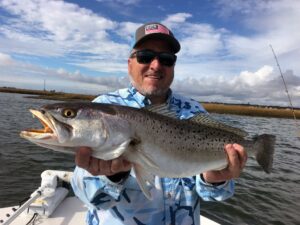 Renowned for its beautiful coastline and diverse marine life, southeastern North Carolina is a premier destination for inshore fishing enthusiasts. From the thriving estuaries to the calm, inshore waters, the area provides ample opportunities for a memorable fishing experience. This guide will delve into everything you need to know about planning and participating in a guided inshore fishing trip in this unique location.
Inshore fishing, or nearshore fishing, typically takes place in shallow waters up to 30 meters deep, making it an accessible and popular form of fishing. In southeastern North Carolina, the inshore fishing scene is rich and varied, offering a diverse array of species from Red Drum, Flounder, Speckled Trout to Sheepshead and Black Drum.
The appeal of inshore fishing lies not only in the excitement of the catch but also in the chance to experience the region’s remarkable coastal beauty and diverse ecosystems. It’s a pastime that combines patience, skill, knowledge of local fish species, and their habits.
Renowned for its beautiful coastline and diverse marine life, southeastern North Carolina is a premier destination for inshore fishing enthusiasts. From the thriving estuaries to the calm, inshore waters, the area provides ample opportunities for a memorable fishing experience. This guide will delve into everything you need to know about planning and participating in a guided inshore fishing trip in this unique location.
Inshore fishing, or nearshore fishing, typically takes place in shallow waters up to 30 meters deep, making it an accessible and popular form of fishing. In southeastern North Carolina, the inshore fishing scene is rich and varied, offering a diverse array of species from Red Drum, Flounder, Speckled Trout to Sheepshead and Black Drum.
The appeal of inshore fishing lies not only in the excitement of the catch but also in the chance to experience the region’s remarkable coastal beauty and diverse ecosystems. It’s a pastime that combines patience, skill, knowledge of local fish species, and their habits.
Frequently Asked Questions
- What is a guided hunting trip?
A guided hunting trip is an organized hunting experience led by a professional guide or outfitter. The guide provides the necessary logistics, hunting expertise, knowledge of local regulations, and a safe and ethical hunting environment. - What is special about wild turkey hunting in southeastern North Carolina?
Southeastern North Carolina, with its mix of dense pine forests, hardwood bottomlands, and swampy areas, provides an ideal habitat for wild turkeys. The varied terrain adds to the appeal, offering hunters a unique and satisfying hunting experience. - What can I expect from wild hog hunting in southeastern North Carolina?
The region, characterized by a diverse blend of terrain from dense forests to marshy wetlands, is a flourishing habitat for wild hogs. In southeastern North Carolina, the thriving hog population across the dense forests, agricultural lands, and swampy areas provides ample opportunities for an unforgettable hog hunting adventure. - Why is southeastern North Carolina a good place for deer hunting?
Southeastern North Carolina is rich with dense forests, wide-open agricultural lands, and an abundance of white-tailed deer. The varied landscape offers hunters a range of hunting scenarios, each with its unique challenges and rewards. - What is unique about Clapper Rail hunting in southeastern North Carolina?
Southeastern North Carolina is a haven for Clapper Rails, with its extensive saltwater marshes and coastal ecosystems. The region provides ideal habitats for these birds and, consequently, ample opportunities for hunters to engage in this unique hunting experience. - Why should I consider inshore fishing in southeastern North Carolina?
Renowned for its beautiful coastline and diverse marine life, southeastern North Carolina is a premier destination for inshore fishing enthusiasts. The inshore fishing scene is rich and varied, offering a diverse array of species from Red Drum, Flounder, Speckled Trout to Sheepshead and Black Drum.
Seahawk Outdoors Guided Hunting Trips
